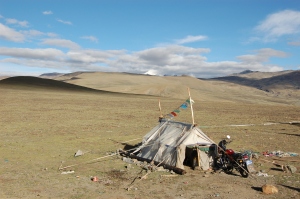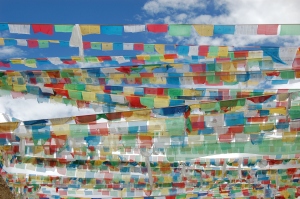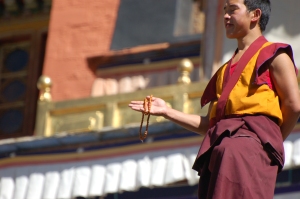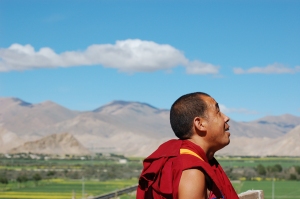The continuation & conclusion to last week’s post, “Finding China, beneath the yellow fog”
Thankfully, age has not jaded Jinshanling,a town that has instantly won my vote for ‘favorite place’ in the People’s Republic of China. Like a sheltered child, the ancient village has a lovely innocence about it. Nowhere is this more apparent than at Jinshanling’s communal village toilets — just below The Great Wall’s ramparts — a place that harkens me back to a more innocent bygone era. There’s just a wide open “door,” nothing more than an opening in the wall, open to the main street. Villagers come and go like it’s no big deal. Inside the toilet’s stone walls, rows of holes carved in long slabs of stone over a flowing “river” constitute the toilets. I count at least 50 of these. I know I must try this, just once. I hope, pray, that no one else comes in; I complete my business with the speed of a Nascar racetrack mechanic.
It’s clear to me now that Jinshanling is not a place many foreign tourists come to —er, experience things like this. Or to stay. The military require that all visitors buy a pass to visit the Great Wall of China before they’re allowed to enter the village, and there are just two guesthouses. A foreigner would probably be suspect if he said he simply wanted to poke around town; he’d most likely have to pay, Wall or no Wall.
Most tourists usually come and go in a day, taking a quick walk up to the Great Wall, riding the creaky gondola (salvaged and moved from a defunct amusement park) up to a viewpoint, and snapping photos before heading back to Beijing.
Once paid up and inside the gate, we see a giant parking lot with huge spaces for tour buses. Next to the parking lot sits a row of identical 10-foot-by-10-foot stores with identical blue garage doors. Shopowners stand out front and shout “water!, water!” if anyone passes by. Inside each shop stocks identical bottles of water and Coca-Cola. I didn’t see anything else in these stores— except potato chips.
We drive the equivalent of three city blocks to where the town ends. Jinshanling has only one street. The street leads directly up to the Great Wall. We park the van just off the road in a gravel lot and Hai Li introduces us to Mr. Wong, one of the town’s shop owners. We rest at a plastic table in front of Mr. Wong’s store in an old brick building that abuts the street. We eat peanuts and drink beer before setting out for the first itinerary item: a short evening climb up onto the Great Wall of China.
We walk on The Wall only as far we can until signs tell us to stop walking. We quickly hit a militarized zone, where Chinese soldiers train in the rugged hills. On the way up, I run my right hand along the old stones of the Great Wall, and it feels exhilarating to be touching something so historically significant. At the top, we pause to take in the view of the forested hillsides dropping below us on either side of the wall. Like a snake disappearing into a burrow, The Great Wall disappears into the smog in both directions, even though from here it stretches at least 2,000 miles each way. There is no sunset to see, as the smog is deeply settled in the hills all around us. Mr. Wong points over The Wall and says all of that was once Mongolian territory. Smog obscures the view in that direction, too.
The Wall once stopped the Genghis Khan, but it can’t stop the wafting cloud of pollution from Beijing. Smog can travel up to 300 miles a day, much faster than Khan’s armies ever could, and can scale the Great Wall effortlessly.
DINNER IN THE STREET
It’s dusk by the time we scramble back down the steps and set foot in Jinshanling again. When we arrive, Mr. Wong’s wife, her sister and a handful of cousins and friends have made dinner for us in the Wong house behind the shop. We eat on a white plastic table set out on the street as Mr. Wong’s children dart under and around our table.
Giddy and talkative from the rice wine and beer, we set out with flashlights to go back up to the Wall, but this time in a different direction than before, along a wooded path that switch-backs. Our watchtower awaits. Tomorrow, we’ll walk the other direction — away from the militarized zone — for about eight miles until we reach another village.
Mr. Wong and Hai Li lead the way up an ancient stone staircase. We have to use our hands to brace ourselves as we climb into the tower. Mr. Wong, though, does it carrying a plastic fold-up table and chairs. Hai Li negotiates it carrying our breakfast food in a bag. After setting up our sleeping mats and sleeping bags, we spend the evening enjoying the rice wine and practicing our English with our hosts. We’re laugh and laugh until at least 1 am, but no one is near enough to hear.
Our toilet is a plastic bucket in a far corner of the watchtower, with no curtain and no toilet paper. Another ‘real China’ moment. As night settles in, the yellow fog disappears and the stars appear.
Since the long flight from the U.S. to Beijing, I’ve been suffering from an ear infection, and I can barely hear out of one ear now that we’re camping on the Wall. The ocean is crashing inside my head, and we’re nowhere near the ocean. And there’s loud ringing too, though this is a quiet place. My equilibrium is off too, so my steps are slow, deliberate. I do my best to sleep; when I can’t, I look up at the stars from this incredible watchtower perch.
Still feeling my cold the next morning, I eat hot Chinese noodles from a box for breakfast, the spicy beef flavor. Mr. Wong boiled the water before the rest of us rose. Hai Li says it should help my cold. That’s what she eats when she has one. She is sincere, and I can’t help but smile.
We set out after breakfast and begin to hike. Within the first two hours a stifling heat settles in, and with it more smog from faraway Beijing. Little ladies and old men selling Coke and guidebooks and postcards sit inside some of the watchtowers. They shout out “post-card?” “cold water?” “guidebook?” in broken English as we approach. But other than the vendors we only see a few other people on The Wall all day. With the exception of two European women near Simatai, they are all Chinese.
The walk is long and hard and stunning all at the same time. Some of the steps are so steep and crumbling that it helps to steady myself with my hands. By the time we reach Simatai, where lunch awaits, we are overheated and exhausted. The temperature has risen to nearly 100 degrees. I’m amazed and humbled by the Chinese laborers who built The Great Wall.
WESTERN, IN LOOKS ONLY
It’s a relief to get back to Jinshanling, where we can clean up, rest, and with time, cool off with the setting sun. But Jinshanling is a place not entirely braced for sweaty Westerners. Perhaps we want too much relief. After the hike, we’re out of drinking water. My husband, gracious, tells me to take a shower first while he goes out to the bottled-water-and-Coke-shops to (hopefully) find some bottles of water for us. I shower in the dark bathroom where the water comes out of a spigot in the wall between the toilet and sink. When my husband returns, there is no bottled water. The few shops still open at 4 pm have soda only, and warm beer. He brings back a 2-liter of Coca-Cola.
And as my husband steps into the shower, there is no water for him. Not even to flush the toilet. We would soon find out, through Hai Li translating for the woman at the front desk, someone suddenly turned off the entire town’s water supply.
“When the farmers need the water for their crops, the water supply to the village is shut off,” the woman tells my husband. “It will come back on eventually. Just wait a while.”
Wondering how long he would wait, my husband asked if he could call the front desk from our room to check in if necessary. With a sweet, matter-of-fact voice, the woman answered:
“Oh, the room telephones aren’t actually connected to anything. They’re just for decoration.”
SONGS…AND SILENCE
On our last morning in Jinshanling, Hai Li suggests we ride the gondola up to a special viewpoint, so we can get a panoramic view of The Wall. The smog is clearing, just a little, and the sun is as hot as ever. At 10 am, the temperature is already approaching 85 degrees.
My husband and I knock heads scrambling into the tiny gondola carriage, a Plexiglass contraption barely big enough for two adults. The cars do not stop or slow down in the loading zones. Once we are inside for a few minutes, the car becomes stiflingly hot.
The Carpenter’s plays from a loudspeaker attached to each support tower, blaring “Every sha-la-la-la, every oh-oh-oh-oh …”. My husband and look at each other and smile, and the song fades again until our car rattles up to the next tower, “Every shing-a-ling-a-ling . …”
Once at the top, the music stops. I wonder, were The Carpenters our in-gondola entertainment? Is talk – or silence, for that matter — too dangerous in China? We are the only riders on the gondola this morning, and once we are off at the top, the operators, sitting in little sheds at the top and bottom, stop the whole apparatus.
Up here, there is not much except a hillside with some paths leading uphill – our lookout spot. We reach the top of the rise to see The Great Wall. This time, the Wall is actually below us.
The smog is thinner today, and we can see it stretch long in both directions. We take a breath to take it all in and … whomp! Chinese propaganda music blares from behind, a kind of Communist anthem. Someone has set up a loudspeaker on top of a telephone pole. It’s loud and jarring and shrill and echoes down the hillsides and off the Great Wall. The next song is a less brassy, but no less amplified.
The music doesn’t seem to bother Hai Li, who begins picking nuts off nearby trees, filling a plastic bag. It’s a family tradition to cook the nuts with vegetables, she says.
“Good for health,” she says, one of her favorite things to say. She also says this about Jinshanling’s rice wine.
She is soon joined by three old women picking the same nut. They claim this nut is hard to find in stores, and is expensive. As she sidesteps down an precipitous slope to reach a tree, my husband decides it’s time to help her. I take a picture of the old women, who are happy to pose, with the Great Wall in the background and the all-important nut trees in the foreground.
The music abruptly stops. The women smile. I click the camera, and snap a “Real China” moment.






